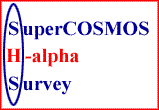
|
|
|
|
|
|
|
|
|
|
|
|
|
|
|
|
|
|
|
|
| |
 | |
| IFA ROE |
Catalogue Parameters in the SHS
Celestial Coordinates
Global astrometry is tied to the Tycho-ACT reference catalogue, and the mean positional errors will be around 0.2" for bright stars. Very faint objects will have increased random noise and additional systematic error at a similar level (a few tenths of an arcsecond). For the SHS both equatorial RA/Dec and Galactic l,b co-ordinates are provided for each detected object.
Calibrated Magnitudes
Roughly calibrated magnitudes are provided in this parameter. These are currently tied to bright photometry from the Tycho and Guide Star Photometric Catalogues. Field-to-field zeropoints have been removed, and the calibrations are tied to faint CCD standards from Croom et al. (1999, MNRAS, 306, 592), Boyle et al. (1995, MNRAS, 276, 33), Stobie et al. (1985, A & AS, 60, 503), Cunow et al. (1997, A & AS, 125, 71 and references therein), Maddox et al. (1990, MNRAS, 246, 433) and Collins (private communication). Bright stars will have systematic errors as a function of position on the plate. Systematic errors of a few tenths of a magnitude will be likely; errors of 0.5 mag or more are less common but nonetheless present. Note that stellar magnitudes are based on calibrated profile magnitudes. In the SSS galaxian magnitudes are calibrated isophotal magnitudes, sky divided and corrected to total magnitudes.Note that for the broad-band R magnitudes from the short-red (SR) exposures, the emulsion is Tech-Pan and not IIIaF. Hence although the broad-band filter (RG630) is the same as for R magnitudes in the SSS from IIIaF plates, the emulsion is different. The emulsion sensitivity curve is slightly different and the emuslion cut-off is slightly less extended in the red. Fortunately the differences are slight and good agreement between the R-magnitudes obtained from both Tech-Pan and IIIaF are obtained and the colour term very modest.
In the galactic plane, the vast majority of images are stellar with modest numbers of true galaxies being detectable. However, due to the crowded nature of the plane fields, many stellar images are blended with 2 or more components which often leads to the Image analyser determining galaxian image parameters for these blends (this problem is also present at higher galactic latitudes but at a much reduced frequency). In light of this a decision was taken to assume all detected images in the SHS are stars for the purposes of photometric determinations. This was assumed for both the H-alpha and matching SR scans. Hence the ocassional `true' galaxy'detected in the SHS IAM data will have the wrong magnitude. However it is assumed that anyone interested in finding galaxies in the Southern Galactic Plane will use DENIS or 2MASS detections.
H-alpha R-equivalent magnitudes
In the narrow-band H-alpha images (fwhm of inteference filter is only 70Angstroms) magnitude estimates are not strictly applicable. However, for point source continuum objects it is clear that the same images are visible on both the H-alpha and matching SR and that indeed the depths are very similar. Thus for convenience of comparison between the broad-band and narrow-band images an R-equivalent magnitude was adopted for all images detected in the H-alpha exposures with values determined in the same way as if they were R broad-band magnitudes. Hence a continuum source in the H-alpha exposure would have an R-equivalent magnitude very similar to that in the broad-band case. True H-alpha emitting point sources such as be stars and T-tauri stars would have brighter R-equivalent magnitudes.Word of caution: Unfortunately the H-alpha R-equivalent magnitudes and their broad-band counterparts will not always be sufficient to identify true H-alpha emitters. This is because many late type stars have a prominent TiO band which falls in the H-alpha band-pass. The stronger TiO bands redward of this are outside the band-pass. This can lead to elevated R-equivalent magnitudes for such sources when compared to the standard R-magnitude for the same object. When the Galactic Plane I-band survey is incorporated it will be straightforward to identify and eliminate such contaminants.
SuperCOSMOS Magnitudes
The full 32 IAM parameter sets for each exposure have two instrumental magnitudes called COSMAG and PRFMAG. The COSMAG parameter is an isophotal magnitude (-2.5log{sum of intensities of thresholded pixels above sky}) while the PRFMAG parameter is a `linearised' profile magnitude computed following the prescription of Bunclark & Irwin (1983, Proc. Statistical methods in Astronomy Symp., ESA SP-201, 195)
Classification Flag
Image classification (based on morphological parameters and areal profile shape) provides a classification flag: 1=galaxy, 2=star, 3=unclassifiable, 4=noise. In listings showing the full 32 object parameters the profile classification stage also writes a classification statistic which is 1000x the number of sigmas an image profile set is away from the mean stellar areal profile set at that particular brightness and position on the plate. A "linearised" profile magnitude is also written and is used for stellar magnitude calibration. Note that many blended stellar groups can fool the analyser into a galaxian classification.
Quality Flag
The quality flag gives and indication of how "good" an image is in the sense that the higher the value, the more likely an image is to be spurious. Bits are set in this flag by the image analysis software such that more severe conditions are flagged using more significant bits. The nominal threshold for a severe defect is 65535 - images having a quality value less than this value but greater than zero are not necessarily spurious. non-zero values should be regarded as a warning of possible problems with the image.
Home | Intro | Get an Image | Get a Catalogue
Coverage | Documentation | History | Links
WFAU, Institute for Astronomy,
Royal Observatory, Blackford Hill
Edinburgh, EH9 3HJ, UK
M.Read@roe.ac.uk
30/7/2008